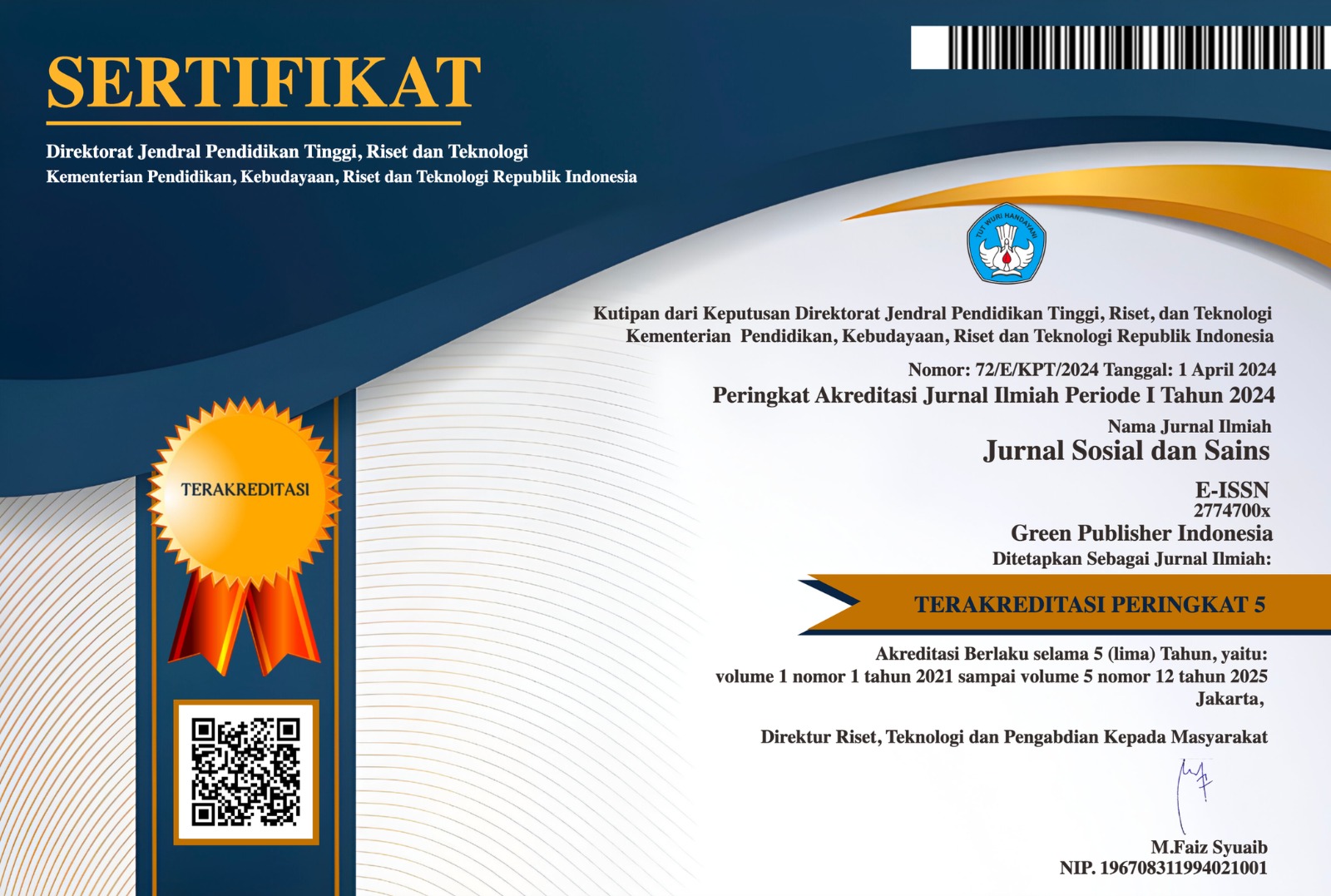Economic and Institutional Determinants of Export Growth in Asean: Evidence from a Regional and Bilateral Perspective
DOI:
https://doi.org/10.59188/jurnalsosains.v5i9.32521Keywords:
ASEAN, Export growth, Macroeconomics, Bilateral tradeAbstract
The ASEAN region has emerged as a vital hub in global trade, yet the determinants of its export performance—particularly from both regional and bilateral perspectives—remain underexplored in a cohesive empirical framework. The study investigates factors affecting export growth in the ASEAN economy over the sample period of 1996–2023 from a regional and bilateral trade flows perspective. The ASEAN countries sample includes Indonesia, Singapore, Malaysia, Thailand, and the Philippines. We employ panel regression techniques to examine the impact of GDP growth, inflation, globalization, political stability, and exchange rate growth on export growth. The findings show that GDP growth and exchange rate growth positively drive export growth, while inflation reduces export growth. In contrast, globalization, political stability, and COVID-19 have not significantly affected export growth in the region. Furthermore, at the bilateral level, the findings are more heterogeneous. Among all variables, GDP growth and exchange rate growth dominate as significant determinants of bilateral export trading in the region. Overall, the results demonstrate that a one-size-fits-all policy cannot explain the trade dynamics of ASEAN; it requires country-specific policies with structural reforms to enhance regional integration.
References
Abdi, A. H., Zaidi, M. A. S., & Karim, Z. A. (2023). Economic complexity and bilateral trade flows in selected COMESA and East Asia countries. Technological and Economic Development of Economy, 29(3), 846–873.
Adhikari, P. K. (2024). Macroeconomic determinants of bilateral trade: Evidence from India and Nepal. Journal of Management, 7(1), 80–97.
Aggarwal, S. (2023). The empirical measurement and determinants of intra-industry trade for a developing country. Journal of Applied Economic Sciences (JAES), 18(3(81)), 182–220.
Baldwin, R. (2016). The great convergence: Information technology and the new globalization. Harvard University Press.
Boughanmi, H., Al-Shammakhi, A., & Antimiani, A. (2016). Deeper integration or wider integration?: The case of Gulf cooperation council. Journal of Economic Integration, 206–233.
Byiers, B., Vanheukelom, J., & Kingombe, C. K. M. (2015). A five lenses framework for analysing the political economy in regional integration. Africa Economic Brief, 6(3), 1–10.
Dang, G., & Pheng, L. S. (2015). Infrastructure investments in developing economies. Springer Science Business Media Singapore. https://doi.org/10.1007/978981
Espitia, A., Rocha, N., & Ruta, M. (2022). Covid-19 and food protectionism. American Economic Review: Papers & Proceedings, 112, 254–259. https://doi.org/10.1596/1813-9450-9253
Gedefie, G. D., Wu, S., & Sher, A. (2025). Economic and institutional factors influencing bilateral trade in mining and quarrying between China and Africa: A gravity model analysis. Environment, Development and Sustainability, 1–31. https://doi.org/10.1007/s10668-025-02159-1
Houthakker, H. S., & Magee, S. P. (1969). Income and price elasticities in world trade. Review of Economics and Statistics, 51(2), 111–125. https://doi.org/10.2307/1926720
Jovanović, M. N. (2015). The economics of international integration (2nd ed.). Edward Elgar Publishing.
Kurul, Z. (2023). Hard and soft factors of trade facilitation and export diversification: Evidence for developing and the least developed countries. The Developing Economies, 61(2), 75–116.
Mao, H., Cui, G., Hussain, Z., & Shao, L. (2024). Investigating the simultaneous impact of infrastructure and geographical factors on international trade: Evidence from Asian economies. Heliyon, 10(1), e23354. https://doi.org/10.1016/j.heliyon.2024.e23354
Milner, H. V. (2017). The political economy of international trade. In Global trade (pp. 91–114). Routledge.
Nguyen, T. T., & Vo, D. H. (2017). Determinants of bilateral trade flows in ASEAN+3: A gravity model approach. Journal of Asian Economics, 49, 60–73. https://doi.org/10.1111/apel.12185
Pietrangeli, G. (2016). Supporting regional integration and cooperation worldwide: An overview of the European Union approach. In The EU and world regionalism (pp. 9–43).
Rodrik, D. (2018). Straight talk on trade: Ideas for a sane world economy. Princeton University Press.
Shimizu, K. (2021). The ASEAN Economic Community and the RCEP in the world economy. Journal of Contemporary East Asia Studies, 10(1), 1–23.
Situmorang, R., & Agustina, N. (2021). Determinants of service exports in ASEAN. Journal of Economic Integration, 36(2), 215–238. https://doi.org/10.34123/icdsos.v2021i1.129
Suci, S. C., Asmara, A., & Mulatsih, S. (2015). The impact of globalization on economic growth in ASEAN. Bisnis & Birokrasi, 22(2), 79.
Weatherbee, D. E. (2019). ASEAN’s half century: A political history of the Association of Southeast Asian Nations. Bloomsbury Publishing PLC.
Yuliadi, I., Basuki, A. T., & Ayuningtyaswati, D. (2024). Determinants of import in ASEAN Economic Community. International Journal of Professional Business Review, 9(1), e04043. https://doi.org/10.26668/businessreview/2024.v9i1.4043
Zhai, H. (2023). Evaluation of China-ASEAN trade status and trade potential: An empirical study based on a gravity model. PLOS ONE, 18(9), e0290897. https://doi.org/10.1371/journal.pone.0290897
Downloads
Published
How to Cite
Issue
Section
License
Copyright (c) 2025 Jagat Prirayani

This work is licensed under a Creative Commons Attribution-ShareAlike 4.0 International License.
Authors who publish with this journal agree to the following terms:
- Authors retain copyright and grant the journal right of first publication with the work simultaneously licensed under a Creative Commons Attribution-ShareAlike 4.0 International (CC-BY-SA). that allows others to share the work with an acknowledgement of the work's authorship and initial publication in this journal.
- Authors are able to enter into separate, additional contractual arrangements for the non-exclusive distribution of the journal's published version of the work (e.g., post it to an institutional repository or publish it in a book), with an acknowledgement of its initial publication in this journal.
- Authors are permitted and encouraged to post their work online (e.g., in institutional repositories or on their website) prior to and during the submission process, as it can lead to productive exchanges, as well as earlier and greater citation of published work.








